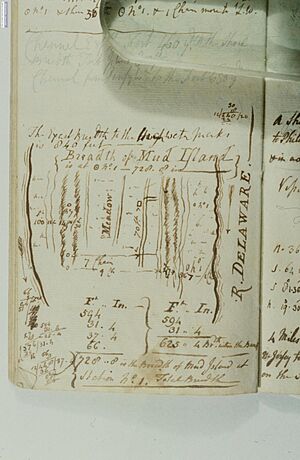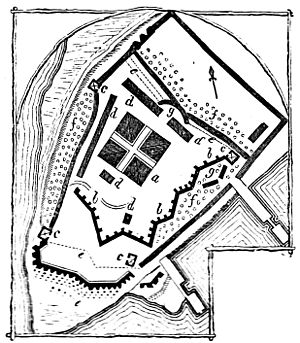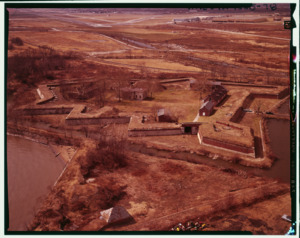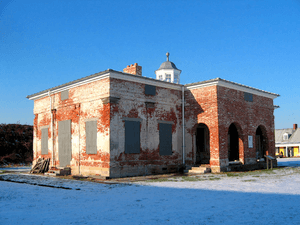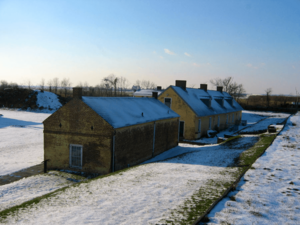Fort Mifflin facts for kids
Quick facts for kids Fort Mifflin |
|
|---|---|
| Philadelphia, Pennsylvania, U.S. in United States | |
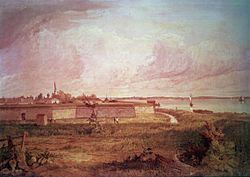
An 1870 portrait of Fort Mifflin in Philadelphia by Seth Eastman, commissioned by the U.S. Army
|
|
| Site information | |
| Owner | City of Philadelphia |
| Operator | United States Army Corps of Engineers |
| Open to the public |
yes |
| Site history | |
| Built | 1771 - 1776 |
| Battles/wars | Siege of Fort Mifflin |
|
Fort Mifflin
|
|
| Location | Fort Mifflin Road Philadelphia, Pennsylvania, U.S. |
| Architect | John Montresor Pierre Charles L'Enfant Louis de Tousard |
| NRHP reference No. | 70000554 |
| Significant dates | |
| Added to NRHP | August 29, 1970 |
| Designated NHL | August 29, 1970 |
Fort Mifflin, first known as Fort Island Battery, is a very old fort near Philadelphia, Pennsylvania. It was built on Mud Island in the Delaware River starting in 1771. Today, it's close to the Philadelphia International Airport.
This fort played a big role during the American Revolutionary War. In 1777, the British Army attacked and took over the fort. This was part of their plan to capture Philadelphia.
Later, in 1795, the fort was renamed after Thomas Mifflin. He was an officer in the Continental Army and the first governor of Pennsylvania after America became independent. The U.S. Army rebuilt and used the fort for many years.
During the American Civil War, Fort Mifflin held prisoners. The U.S. Army stopped using it for active soldiers in 1962. Today, parts of the fort are still used by the United States Army Corps of Engineers. This makes it the oldest fort still in use by the U.S. military!
People have worked hard to restore the fort. It is now a National Historic Landmark, which means it's a very important historical place.
Contents
Fort Mifflin's Amazing History
Protecting Philadelphia Long Ago
Philadelphia was founded in 1681 near two rivers, the Delaware and Schuylkill. People knew this spot was important for defense. However, William Penn, who founded Philadelphia, was a Quaker. Quakers believed in peace and did not want military defenses.
Because of this, Philadelphia was one of the only big European settlements without forts. The Quakers tried to make peace with Native American tribes instead of fighting. While other colonies had wars, Philadelphia grew and became rich.
By the 1740s, Philadelphia was a very busy British port. Ships from France and Spain, called privateers (like legal pirates), started to threaten the city. During King George's War (1744-1748), Benjamin Franklin helped create a local army. The city's leaders, mostly Quakers, did not want to build forts or warships. Franklin raised money for defenses and cannons.
After that war, the defenses were left to fall apart. In the 1750s, during the French and Indian War, there were plans for a fort on Mud Island. But no fort was built then. Philadelphia finally got permanent forts in the 1770s.
By 1771, Philadelphia was the biggest British port in North America. People there were upset about British rules and taxes. The governor, John Penn, asked General Thomas Gage for help. He wanted someone to design defenses for the city. This fort on Mud Island would control ships entering and leaving the port.
Captain John Montresor of the British engineers was given the job. He showed six designs for a fort on Mud Island. The city leaders thought all the plans were too expensive. Montresor wanted a fort with 32 cannons and 400 soldiers. The local government agreed to spend £15,000 to build the fort and buy Mud Island.
Montresor started building, but he felt he didn't have enough money. He left in 1772, and the project slowed down. Only the east and south stone walls were finished at that time.
Fort Mifflin in the Revolutionary War
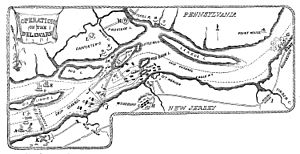
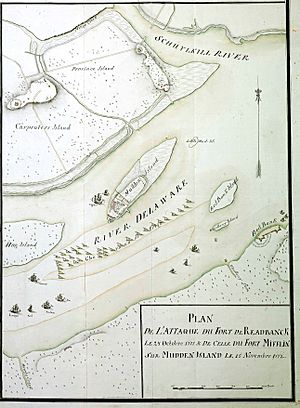
After America declared independence, Benjamin Franklin helped lead a group to defend Philadelphia. This group quickly restarted work on Fort Mifflin. The fort was finally finished in 1776.
At the same time, another fort, Fort Mercer, was built across the Delaware River in New Jersey. These two forts were meant to stop the British Navy from using the Delaware River. They would protect Philadelphia from General Howe and Admiral Reynolds.
To make it even harder for British ships, Americans placed obstacles called chevaux de frise in the river. These were huge wooden frames filled with stones. They had sharp iron spikes pointing downstream, hidden underwater. These could rip holes in enemy ships. Only American sailors knew the safe paths through these obstacles. Soldiers at Fort Mifflin and Fort Mercer could shoot at anyone trying to remove them.
In September 1777, the British took Philadelphia after the Battle of Brandywine. They then attacked Fort Mifflin and Fort Mercer. They wanted to open up the Delaware River for their supply ships. The British attacked Fort Mercer by land and river in the Battle of Red Bank, but they failed.
The same engineer who first designed Fort Mifflin, Montresor, now planned the British attack against it. On November 10, 1777, the British began a huge cannon attack on Fort Mifflin. One soldier, Joseph Plumb Martin, later wrote about the intense battle.
American ships, led by Commodore John Hazelwood, also fought back. They attacked British positions on shore and patrolled the river. On November 15, 1777, the Americans had to leave Fort Mifflin. But their brave fight had stopped the British Navy for long enough. This allowed the Continental Army to move safely to Valley Forge.
Fort Mifflin saw the heaviest bombing of the entire Revolutionary War. About 250 of the 400-450 American soldiers at the fort were killed or wounded. These brave soldiers were moved to the mainland before the final evacuation. Fort Mifflin never saw battle again.
Today, you can still see the original white stone walls of the fort. The marks on these walls show how intense the British attack was in 1777. Locals remember this battle as the Battle of Mud Island.
Rebuilding for Future Wars
Fort Mifflin was left in ruins until 1793. Then, rebuilding started as part of America's first plan for coastal defenses. In 1794, Pierre L'Enfant, who also designed Washington, D.C., oversaw the new plans.
Work continued under engineer Louis de Tousard from 1795 to 1800. The goal was to fit 48 cannons in the fort. The inner rooms of "Casemate #11" might be from the first building in 1771. The outer room was likely built between 1794 and 1798. It was used to make cannon charges.
Barracks for soldiers were built in the 1790s. They were two stories tall and had seven rooms. Five of these rooms could house 25 men each. In 1795, the fort was officially named after Thomas Mifflin. Rebuilding the fort cost a lot of money, over $94,000 by 1799. Philadelphia was the U.S. capital until 1800, so Fort Mifflin was well-guarded.
In 1796, a citadel (a strong central fortress) was built to house the commandant. Lieutenant Colonel Stephen Rochefontaine finished this building in 1798. The Commandant's House is a good example of Greek Revival architecture.
Between 1798 and 1801, six cavelike casemates were built. These were defensive structures to protect soldiers during an attack. One casemate was a barracks, and others were for storage. Casemate #5 was meant to be the fort's headquarters during a battle. A "bake oven" near the main gate was used for baking bread, as a chapel, and a dining hall.
The blacksmith shop was built before 1802 and is one of the oldest buildings still standing. In 1814, a two-story officers' quarters was added. By 1811, Fort Mifflin had 29 heavy guns and barracks for 100 soldiers.
Life at the Fort Before the Civil War
From 1815 to 1816, a brick guardhouse and prison were built. Around 1819, a building north of the fort walls became a hospital and dining hall.
After Fort Delaware was built in 1820, Fort Mifflin became less important. Over the 19th century, Mud Island was connected to the mainland. Even so, building and guarding Fort Mifflin continued. In the 1820s, soldiers at the fort started recording weather observations.
The soldiers' barracks and officers' quarters were updated in 1836. The barracks later got a second floor. In 1837, the hospital became a meetinghouse. An artillery shed was built to store cannons.
By 1839, the guardhouse-prison was used as an arsenal (for weapons). In 1842, a storehouse for a "sutler" (a merchant who followed the army) was completed. In the 1840s, a kitchen was added to the officers' quarters.
Fort Mifflin During the Civil War
During the American Civil War, Fort Mifflin was used as a prison. It held Confederate soldiers, as well as some Union soldiers and civilians. Many Confederate prisoners were kept in Casemate #1 from 1863 to 1865. Three smaller casemates held political prisoners. You can still see graffiti from the 1860s on the walls of "Casemate #11."
One famous prisoner was William Howe, a Union soldier accused of desertion and murder. He was imprisoned at Fort Mifflin in 1864. Howe tried to escape with 200 prisoners from Casemate #5. After that, he was put in solitary confinement in Casemate #11, where he signed his name. Howe wrote letters to President Abraham Lincoln asking for mercy. He was later executed at the fort.
In 1864, the army planned to add a "sally port" (a hidden exit) on the west side. In November 1864, Lieutenant Colonel Seth Eastman, a famous painter, came to Fort Mifflin. He oversaw the release of over 200 prisoners. By January 1865, his group included soldiers and hospital staff.
After the Civil War: Changes and Updates
In August 1865, Captain Thomas E. Merritt took over from Lieutenant Colonel Eastman. The west sally port was finished by 1866. The army stopped using the fort for soldiers that year.
From 1866 to 1876, engineers repaired and updated Fort Mifflin. They also improved its weapons. They worked on a new battery south of the fort, but it was never finished. In 1874–1875, a "torpedo casemate" (for underwater mines) was built. Its entrance sealed off an old magazine, "Casemate #11." This helped preserve old items like pottery, buttons, and animal bones.
From 1876 to 1884, the Corps of Engineers managed Fort Mifflin. During World War I, the fort was used to store ammunition. The kitchen wings of the officers' quarters were removed before the 1920s. They were restored in the early 1990s.
In 1923, the Marine Barracks at the fort held the first recorded USMC Birthday dance.
Fort Mifflin in World War II
During World War II, the U.S. Army placed anti-aircraft guns at Fort Mifflin. These guns protected the nearby Naval Ammunition Storage Depot and the Philadelphia Naval Shipyard. Marine Corps units guarded the ammunition depot.
In April 1942, the U.S. Army stationed Battery H of the 76th Coast Artillery Regiment at the fort. This was the first African-American Coast Artillery unit in U.S. military history. In May 1942, the 76th Regiment moved to California. The 601st Coast Artillery Regiment then took their place at Fort Mifflin.
Modernizing Fort Mifflin
In 1954, Fort Mifflin was no longer an active military post. It was one of the oldest forts in continuous use in the nation. The fort's inside was renovated in 1960. In the 1980s, Harold Finigan, the fort's director, renovated its outside.
Saving Fort Mifflin: Restoration Efforts

In 1962, the U.S. government gave Fort Mifflin to the City of Philadelphia. In 1969, architect John Dickey helped restore the Blacksmith Shop.
Today, Fort Mifflin is still used by the United States Army Corps of Engineers. It is the oldest active U.S. military base and the only one that existed before the Declaration of Independence.
In the late 1970s, the Commandant's House was accidentally destroyed by a fire started by Boy Scouts camping there.
In the 1980s and early 1990s, Harold Finigan worked with architects John Dickey and John Milner. They restored many parts of the fort. These included the artillery shed, hospital, officers' quarters, barracks, and the north and west sally ports. They also built a bridge over the moat. During this work, they found that the buildings were painted yellow during the Civil War era.
In 2006, Wayne Irby and Dr. Don Johnson rediscovered Casemate #11. They found many historical items inside, giving us a peek into the past.
What You Can See at Fort Mifflin Today
- Arsenal (where weapons were stored)
- Artillery Shed (for cannons)
- Blacksmith Shop
- Sutler Building/Storehouse (a shop for soldiers)
- Soldiers' Barracks (where soldiers lived)
- Officers Quarters (where officers lived)
- Commandant's House (the commander's home)
- Hospital/Messhall (for medical care and eating)
- West Sallyport (a hidden exit)
- Casemates (bomb-proof rooms)
- East Magazine (for storing gunpowder)
- Casemate #11 (a special historical room)
See also
- Eastwick
- Frankford Arsenal
- Harbor Defenses of the Delaware
- List of coastal fortifications of the United States
- List of forts
- List of National Historic Landmarks in Philadelphia
- National Register of Historic Places listings in Southwest Philadelphia
- Philadelphia International Airport
- Philadelphia Lazaretto
- Schuylkill Arsenal
- Seacoast defense in the United States





